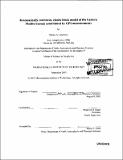Kinematically consistent, elastic block model for the eastern Mediterranean constrained by GPS measurements
Author(s)
Lawrence, Shawn A. (Shawn Adam), 1975-
DownloadFull printable version (10.88Mb)
Other Contributors
Massachusetts Institute of Technology. Dept. of Earth, Atmospheric, and Planetary Sciences.
Advisor
Bradford H. Hager.
Terms of use
Metadata
Show full item recordAbstract
I use a Global Positioning System (GPS) velocity field to constrain block models of the eastern Mediterranean and surrounding regions that account for the angular velocities of constituent blocks and elastic strain accumulation on block-bounding faults in the interseismic period. Kinematically consistent fault slip rates and locking depths are estimated by this method. Eleven blocks are considered, including the major plates, based largely on previous geodetic, seismic, and geologic studies: Eurasia (EU), Nubia (NU), Arabia (AR), Anatolia (AN), Caucasus (CA), South Aegea (AE), Central Greece (GR), North Aegea (NE), Southeast Aegea (SE), Macedonia (MA), and Adria (AD). Two models are presented, one in which the best-fitting locking depth for the entire region (-15 km) is used on all boundaries (Model A), and one in which shallower locking depths are used on the Marmara Fault, the Hellenic and Cyprus Arcs, and in the Greater Caucasus (Model B), based on a consideration of locally best-fitting locking depths. An additional block, Black Sea (BS), is postulated in a third model. The models are in fair to good agreement with the results of previous studies of plate motion, fault slip rates, seismic moment rates and paleomagnetic rotations. Notably, some block pairs in the Aegean region have Euler poles on, or near to, their common boundaries, in qualitative agreement with so-called pinned block models, e.g., for the transfer of slip from the right-lateral North Anatolian Fault system to a set of left-lateral and normal faults in central and northern Greece (McKenzie and Jackson, 1983; Taymaz et al., 1991a; Goldsworthy et al., 2002). (cont.) In addition, roughly three-quarters of the deformation in the Hellenic Arc and Greater Caucasus appears to be aseismic, in approximate agreement with previous studies (Jackson and McKenzie, 1988; Jackson, 1992). Increased data coverage will better constrain block motions, the locations of boundaries and the applicability of this method.
Description
Thesis (S.M.)--Massachusetts Institute of Technology, Dept. of Earth, Atmospheric, and Planetary Sciences, 2003. Includes bibliographical references (p. 43-59).
Date issued
2003Department
Massachusetts Institute of Technology. Department of Earth, Atmospheric, and Planetary SciencesPublisher
Massachusetts Institute of Technology
Keywords
Earth, Atmospheric, and Planetary Sciences.